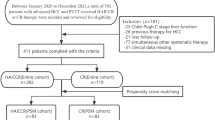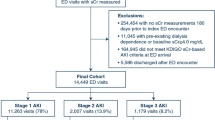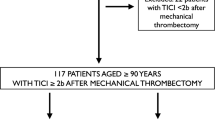Abstract
Purpose
To evaluate prognostic factors associated with peri-procedural (30 days) and short-term (90 days) mortality in the United States cohort of patients following emergent transarterial embolization for ruptured hepatocellular carcinoma.
Methods
Patients with ruptured hepatocellular carcinoma treated with emergent TAE between January 2001 and December 2019 were retrospectively identified (n = 24). Average age was 62 years (range, 23–78 year); 15 (62.5%) were men. Univariate and Cox proportional hazard modeling were used to determine independent predictors of overall survival (OS) following TAE. OS stratified by Model for End-Stage Liver Disease-Sodium score was assessed using Kaplan–Meier analysis.
Results
Twenty-one patients (88%) died during a mean clinical follow-up period of 328 ± 139 days. MELD-Na score (HR 1.22 per 1-unit increase; 95% CI 1.06–1.46; p = 0.005) and pre-rupture ECOG PS score (HR 8.1; 95% CI 1.28–51.2; p = 0.026) were independent predictors of decreased overall survival. There was no significant association between overall survival and presence of cardiovascular co-morbidities (p = 0.60), hemorrhagic shock on presentation (p = 0.16), portal vein thrombus (p = 0.08), vasopressor support required (p = 0.79), intubation required (p = 0.40), acute kidney injury (p = 0.58), and number of packed red blood cell transfusions (p = 0.22). The median OS was 64 days. Median OS was significantly greater in patients with a MELD-Na score ≤ 16 as compared to those with a MELD-Na score > 16 (166.5 days vs 9 days, p = 0.011). Cumulative OS rates in those with a MELD-Na score ≤ 16 at 30, 60, 90, and 360 days were 79%, 64%, 64%, and 25%, respectively, vs 33%, 33%, 11%, and 0%, respectively, in those with a MELD-Na score > 16.
Conclusion
MELD-Na > 16 is associated with very high peri-procedural (67% at 30 days) and short-term (89% at 90 days) mortality in patients with ruptured HCC treated with emergent transarterial embolization. A better understanding of these prognostic factors may help guide treatment decisions and provide realistic expectations when counseling patients and their families.

Similar content being viewed by others
References
Bray F, Ferlay J, Soerjomataram I, Siegel RL, Torre LA, Jemal A. Global cancer statistics 2018: GLOBOCAN estimates of incidence and mortality worldwide for 36 cancers in 185 countries. CA: A Cancer Journal for Clinicians. 2018;68(6):394-424.
Altekruse SF, McGlynn KA, Reichman ME. Hepatocellular carcinoma incidence, mortality, and survival trends in the United States from 1975 to 2005. J Clin Oncol. 2009;27(9):1485-91.
White DL, Thrift AP, Kanwal F, Davila J, El-Serag HB. Incidence of Hepatocellular Carcinoma in All 50 United States, From 2000 Through 2012. Gastroenterology. 2017;152(4):812-20.e5.
Kim HS, El-Serag HB. The Epidemiology of Hepatocellular Carcinoma in the USA. Curr Gastroenterol Rep. 2019;21(4):17.
Vergara V, Muratore A, Bouzari H, Polastri R, Ferrero A, Galatola G, et al. Spontaneous rupture of hepatocelluar carcinoma: surgical resection and long-term survival. Eur J Surg Oncol. 2000;26(8):770-2.
Zhang W, Zhang Z-W, Zhang B-X, Huang Z-Y, Zhang W-G, Liang H-F, et al. Outcomes and Prognostic Factors of Spontaneously Ruptured Hepatocellular Carcinoma. Journal of Gastrointestinal Surgery. 2019;23(9):1788-800.
Sahu SK, Chawla YK, Dhiman RK, Singh V, Duseja A, Taneja S, et al. Rupture of Hepatocellular Carcinoma: A Review of Literature. J Clin Exp Hepatol. 2019;9(2):245-56.
Moris D, Chakedis J, Sun SH, Spolverato G, Tsilimigras DI, Ntanasis-Stathopoulos I, et al. Management, outcomes, and prognostic factors of ruptured hepatocellular carcinoma: A systematic review. Journal of Surgical Oncology. 2018;117(3):341-53.
Kim WR, Biggins SW, Kremers WK, Wiesner RH, Kamath PS, Benson JT, et al. Hyponatremia and mortality among patients on the liver-transplant waiting list. N Engl J Med. 2008;359(10):1018-26.
Khalilzadeh O, Baerlocher MO, Shyn PB, Connolly BL, Devane AM, Morris CS, et al. Proposal of a New Adverse Event Classification by the Society of Interventional Radiology Standards of Practice Committee. J Vasc Interv Radiol. 2017;28(10):1432-7.e3.
Nishikawa H, Kita R, Kimura T, Ohara Y, Sakamoto A, Saito S, et al. Clinical implication of performance status in patients with hepatocellular carcinoma complicating with cirrhosis. J Cancer. 2015;6(4):394-402.
Aoki T, Kokudo N, Matsuyama Y, Izumi N, Ichida T, Kudo M, et al. Prognostic impact of spontaneous tumor rupture in patients with hepatocellular carcinoma: an analysis of 1160 cases from a nationwide survey. Ann Surg. 2014;259(3):532-42.
Lee HS, Choi GH, Choi JS, Han K-H, Ahn SH, Kim DY, et al. Staged partial hepatectomy versus transarterial chemoembolization for the treatment of spontaneous hepatocellular carcinoma rupture: a multicenter analysis in Korea. Ann Surg Treat Res. 2019;96(6):275-82.
Lai EC, Lau WY. Spontaneous rupture of hepatocellular carcinoma: a systematic review. Arch Surg. 2006;141(2):191-8.
Schwarz L, Bubenheim M, Zemour J, Herrero A, Muscari F, Ayav A, et al. Bleeding Recurrence and Mortality Following Interventional Management of Spontaneous HCC Rupture: Results of a Multicenter European Study. World J Surg. 2018;42(1):225-32.
Toshikuni N, Takuma Y, Morimoto Y, Shimomura H, Yamamoto H. Transarterial embolization for ruptured hepatocellular carcinoma: survival predictors. Hepatogastroenterology. 2011;58(106):565-9.
Battula N, Madanur M, Priest O, Srinivasan P, O'Grady J, Heneghan MA, et al. Spontaneous rupture of hepatocellular carcinoma: a Western experience. The American Journal of Surgery. 2009;197(2):164-7.
Fan W-Z, Zhang Y-Q, Yao W, Wang Y, Tan G-S, Huang Y-H, et al. Is Emergency Transcatheter Hepatic Arterial Embolization Suitable for Spontaneously Ruptured Hepatocellular Carcinoma in Child–Pugh C Cirrhosis? Journal of Vascular and Interventional Radiology. 2018;29(3):404-12.e3.
Lee KH, Tse MD, Law M, Cheng AK, Wong HF, Yu ML, et al. Development and validation of an imaging and clinical scoring system to predict early mortality in spontaneous ruptured hepatocellular carcinoma treated with transarterial embolization. Abdom Radiol (NY). 2019;44(3):903-11.
Zhou C, Zu QQ, Liu XL, Wang B, Zhou CG, Shi HB, et al. Treatment strategies and prognosis for initially unresectable ruptured hepatocellular carcinoma: a single-center experience in 94 patients. Diagn Interv Radiol. 2020.
Chalasani N, Kahi C, Francois F, Pinto A, Marathe A, Bini EJ, et al. Model for end-stage liver disease (MELD) for predicting mortality in patients with acute variceal bleeding. Hepatology. 2002;35(5):1282-4.
Amitrano L, Guardascione MA, Bennato R, Manguso F, Balzano A. MELD score and hepatocellular carcinoma identify patients at different risk of short-term mortality among cirrhotics bleeding from esophageal varices. J Hepatol. 2005;42(6):820-5.
Kamath PS, Kim WR, Advanced Liver Disease Study G. The model for end-stage liver disease (MELD). Hepatology. 2007;45(3):797-805.
Lee YR, Park SY, Tak WY. Treatment Outcomes and Prognostic Factors of Acute Variceal Bleeding in Patients with Hepatocellular Carcinoma. Gut Liver. 2020;14(4):500-8.
Hsu CY, Lee YH, Hsia CY, Huang YH, Su CW, Lin HC, et al. Performance status in patients with hepatocellular carcinoma: determinants, prognostic impact, and ability to improve the Barcelona Clinic Liver Cancer system. Hepatology. 2013;57(1):112-9.
Author information
Authors and Affiliations
Corresponding author
Ethics declarations
Conflict of interest
The authors have none.
Additional information
Publisher's Note
Springer Nature remains neutral with regard to jurisdictional claims in published maps and institutional affiliations.
Rights and permissions
About this article
Cite this article
Jundt, M.C., Owen, R.L., Thompson, S.M. et al. MELD-Na > 16 is associated with high peri-procedural and short-term mortality in patients with ruptured hepatocellular carcinoma treated with emergent transarterial embolization. Abdom Radiol 47, 416–422 (2022). https://doi.org/10.1007/s00261-021-03306-2
Received:
Revised:
Accepted:
Published:
Issue Date:
DOI: https://doi.org/10.1007/s00261-021-03306-2




